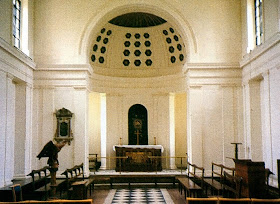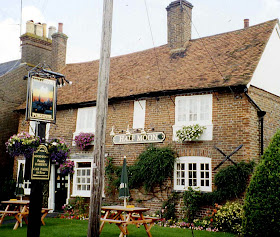HERTFORDSHIRE situated to the north of London is one of the home counties.
A curious grave is to be seen in the old churchyard of St
Mary’s church in the centre of WATFORD. What is said to be a fig tree has grown to
split the gravestone. The grave is said
to be that of an atheist who asked for a fig to be put into his coffin, saying
that if there really was a God,
it would grow into a fig tree.
William Rudston Faulconer
of ABBOTS LANGLEY,
known as ‘Ruddy’, was a stagecoach driver on the London Brighton
run in the late 19th century.
He died in 1928 and was buried in the churchyard at Langleybury close to
the A41. His gravestone appropriately is an OLD MILESTONE bearing his epitaph :
In loving
memory of
WILLIAM
RUDSTON FAULCONER
Of Abbots Langley
Who entered
into rest December 27 1928
Aged 79 years.
‘IN
JOURNEYINGS OFTEN’
The ‘Picture House’ is situated down a country lane near
to the village of BRICKET WOOD. The house, probably Victorian, has many
pictures on the outside walls, in red relief on panels, depicting a variety of
sporting scenes.
Situated by the village pond at SHENLEY is the Cage or
‘lock-up’, a domed-shaped building bearing the inscription ‘Do well. Fear Not.
Be sober. Be Vigilant’. The building served as a temporary prison for those
accused of offences, until the local constable took them to be charged before
the magistrates at Barnet or St Albans Court.
The Cage is thought to date from the 18th century, and is one of the last remaining roundhouse gaols in England.
The Cage is thought to date from the 18th century, and is one of the last remaining roundhouse gaols in England.
It is thought that Patrick Connolly, who killed James Grainge - Special Constable & Shenley Shoemaker - in 1823, was held here under guard overnight before being taken to Hertford Gaol.
This killing was the first
killing of a policeman in Hertfordshire.
The Cage fell into gradual disuse when gaols were built in Barnet and St. Albans. It was used once during the 1914-18 war to confine an army deserter and then again during World War II as an Air Raid Precautions post - complete with telephone.
The Cage has undergone several restorations, most recently in the 1990's.
The Cage fell into gradual disuse when gaols were built in Barnet and St. Albans. It was used once during the 1914-18 war to confine an army deserter and then again during World War II as an Air Raid Precautions post - complete with telephone.
The Cage has undergone several restorations, most recently in the 1990's.
ST ALBANS is a historic cathedral city noted for its Roman history.
If you take the footpath leading down
from the cathedral to the River Ver, you will find there on the riverside, Ye Old
Fighting Cocks Inn, said to be the oldest licensed pub in
England. The octagonal timber-framed
building, which has monastic origins, may have started life as a pigeon cote,
and a place where cock fighting took place – hence its name. Before becoming a fully licensed pub it was
a medieval fishing lodge.
AYOT ST LAWRENCE is a small village near to Welwyn
and the former home of
George Bernard Shaw.
The church of St Lawrence is like a Greek temple, with Doric portico and
two colonnaded wings leading to pavilions on each side, a perfect example of
the Paladin style. The front of the
church is stuccoed, but the back has been left in plain brick, whilst the roof
is of copper sheeting. The very fine
interior is in keeping with the structure and the altar is at the west end.
Sir Lyonel Lyde of Ayot House and
Lord of the Manor in 1778, was responsible for this curious edifice, having
decided to build a new church for the village.
Actually, he decided that the old medieval church obstructed the view
from his house and decided to demolish it and to build the new church to the
west of his house where he could see and
admire it from a distance. Before he
could demolish the old church, the Bishop intervened with an injunction, but
the old building was never restored and was left in ruins as seen today.
The appearance of the exterior of
the new church is due to the fact that Sir Lyonel could only see the front of
the building and this also explains why the altar is at the west end of the
church, i.e the opposite end to the front.
The tombs of Sir Lyonel and his wife
are under the two side pavilions, one on each side. It is said that these unusual separate
mausoleums were the outcome of a life of nuptial discord. Sir Lyonel had apparently vowed that since
the church had united them in life, it should make amends
by separating them in
death.
NORTHCHURCH is a small village near Berkhamstead
A
tiny gravestone stands just opposite the church porch of St Mary’s church.
It bears a
simple inscription :
Peter
The
Wild Boy
1785
WILSTONE is a tiny rural village near Tring.
The
Half Moon pub there was the scene of an
unusual Coroner’s Inquest back in 1751, it was held to inquire into the death of an alleged witch.
Ruth Osborn had been accused of witchcraft
following an incident whilst she was begging for food at Gubblecote, her
subsequent mutterings being interpreted as a curse. Notices were posted that she and her husband
would be publicly ducked at Wilstone on 21st April 1751 . Despite resistance, they were dragged from
their place of refuge in the church vestry by a mob said to number some 4,000
people. They were repeatedly ducked in
the pond at Wilstone, which resulted in the death of Ruth Osborn who had been
physically held under the water by the village chimney sweep, Luke Colley. Colley was subsequently convicted of murder
and was hanged at Hertford Gaol on 24th August 1751 and his body was hung in
chains at Gubblecote.
MARKYATE is a large village on the A5 in Hertfordshire which was on the old Watling
Street coach route between London and the Midlands.
The
Cell is quite an appropriate name for the Old Manor House at Markyate. Built on the site of a former monastery, it
was owned by the Ferrers family from 1548 to 1660. Kathleen Ferrers was born in 1634, and after
an unhappy marriage when she was only 14 years old, she turned to crime as an
escape from what she regarded as a boring life.At night she was transformed when she dressed herself in a three cornered hat, black breeches and coat and then armed with pistols, she rode off along Watling Street on her black horse, to hold up the coaches using that route. One night she was shot and seriously wounded whilst holding up a coach. However, she made her escape and managed to return to a secret room at The Cell. Sadly she died from her injuries but her family hushed up the whole affair and she was subsequently buried with all the pomp befitting her rank and status. Despite the efforts of the family, the legend of the wicked lady of Markyate Cell has persisted to the present time and
it is said that her ghost still appears in the area.





.JPG)






No comments:
Post a Comment